The Panzer 58 development marked the start of a Swiss tank industry, something that did not existed prior to WW2. This lineage went through the Panzer 61, 68 and 88 and ended in 2003. This was Switzerland’s first home-grown main battle tank, a relatively good design overall, especially for the time as it checked all boxes. However limited financial resources never allowed this dometic tank industry to compete with European Giants, in that occurence, Krauss-Maffei Wegmann/Rheinmetall with the Leopard, dominated the European Market.
Apart these 158 G-13 in service, there was nothing to oppose the Soviet onslaught, especially monsters such as the IS-II or IS-III. So in 1949, the Swiss government plan to develop its own domestic tank, based on a pool of capable engineers which already worked on the G-12 and several prototypes, and its solid, albeit small industrial base. It happened after years (1946-49) of looking for an existing foreign design that could fit the bill, being light, cheap, but well armed and armoured. There was no point of licensing a design that proved adequate for the stringent Swiss requirements (and not a lot of choice apart the US). Indeed a that stage, only France tried to ramp up a tank production, but what was presented did not convinced the Swiss.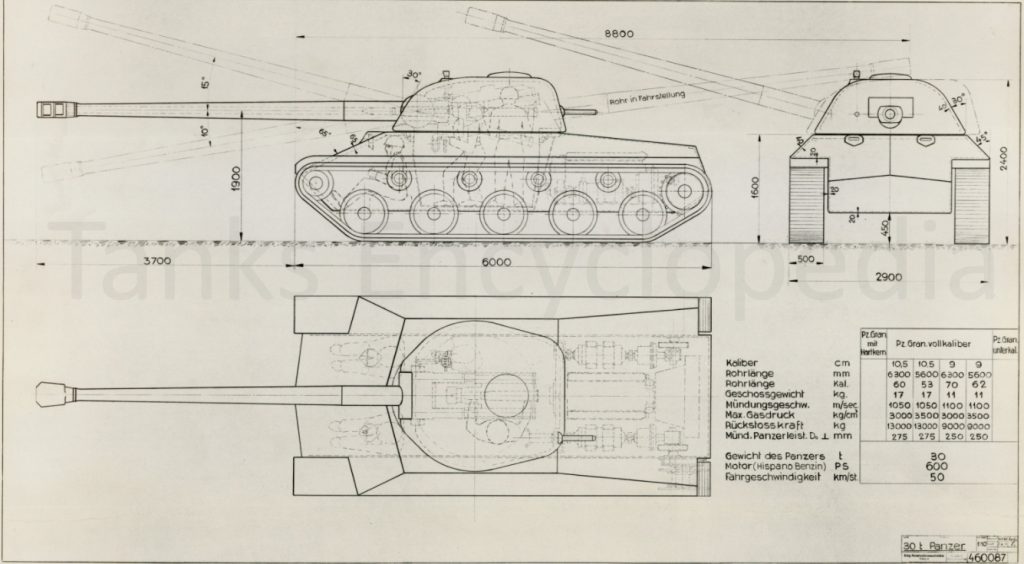
Work on a "mountain tank" with the perfect mobility-firepower-protection balances started thus from scratch, albeit using as technical base the excellent Nahkampfkanone II prototype. Blupeints were ready in 1950, called the KW 1950 ’30ton Panzer’. It had a 600 hp engine and a width of just 3 meters, quite narrow for its time and lenght. Various main guns were studied, before settling on 90 mm and 105 models with different lenght. Secondaries were a coaxial LMG, right of the turret, and rear-left of the turret, manned by the loader. Bets armour figure envisioned was 65 mm (2.56”) on the well sloped glacis front. The rest was pretty light, including 20 mm (0.78”) for the sides. So in this balance, mobility and firepower were preferred. The turret was hemispheric, which was a new trend emerging at the time, useful to obtained a cast, gradually decreased protection. On the base and front, it was 65 mm (2.56”), down to the 45mm (1.77”) for the sides and just 10 mm for the roof and back.
As this design was ironed out, France also approached Switzerland knowing its needs with the AMX-13. This was the Leichter Panzer 51, of which 200 were received later, between 1952 and 1954 and as a stopgap or aletrnative, engieners also worked out on a 15 ton version of the 30 ton Panzer, probably with one axle less, and armour degraded, but a more powerful 9cm L/39 gun that would have been common to the 30 ton design, firing HEAT shells. The 1950 design however was not accepted for production. The copy had to be rewritten, and evolved into the KW 30 1952.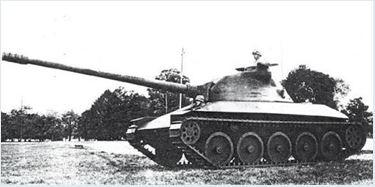 The KW 30 1952 became the blueprint for the initial production vehicle. It was still rather short with its five wheels drivetrain and recalled somewhat the M24 Chaffee, albeit with a better turret and massive new gun. For mobility, the drivetrain remained the same, a 600 hp German Maybach engine that can be built locally, the transmission from the German Tiger for a planned power to weight ratio of 20 hp/ton, rather excellent for the time, better than the T-55. Thanks to its Torsion bar suspension it was able to reach 45 km/h (28 mph) on flat. The main armament was fixed to the domestic 90 mm L/63 (3.5 in) gun and protection 60-70 mm on the turret and glacis front, 45 mm on the sides, which was better than for the initial project. A mockup was created for a presentation, approved in 1953, then a fully working prototype made ready for tests in 1954 which reached 33 tons battle ready. It was still relatively small at 9.7 x 2.9 x 2.55 m (31’9” x 9’6” x 8’4” ft).
The KW 30 1952 became the blueprint for the initial production vehicle. It was still rather short with its five wheels drivetrain and recalled somewhat the M24 Chaffee, albeit with a better turret and massive new gun. For mobility, the drivetrain remained the same, a 600 hp German Maybach engine that can be built locally, the transmission from the German Tiger for a planned power to weight ratio of 20 hp/ton, rather excellent for the time, better than the T-55. Thanks to its Torsion bar suspension it was able to reach 45 km/h (28 mph) on flat. The main armament was fixed to the domestic 90 mm L/63 (3.5 in) gun and protection 60-70 mm on the turret and glacis front, 45 mm on the sides, which was better than for the initial project. A mockup was created for a presentation, approved in 1953, then a fully working prototype made ready for tests in 1954 which reached 33 tons battle ready. It was still relatively small at 9.7 x 2.9 x 2.55 m (31’9” x 9’6” x 8’4” ft).

The final prototype, photo by Yuri Pasholok, CC
Work went on the KW 30 in 1954 and 1955-56 until a last prototype was built in 1957, called the pre-production Prototype. It was significantly different, having notably one more axl, for six per side instead of five but smaller diameter wheels. The drivetrain was also protected by side skirts. The rounded turret was also reshaped and perfected. It was fitted with the Model 48 90mm gun, but also a coaxial Bührle 20mm 5 TG autocannon. Hiowever since Switzerland also acquired in complement to the AMX-13, the larger Panzer 55 (Centurion II), the British 20 pdr gun was chosen instead, based on a generous stoc provided by Britain, working on the famous 105 mm L7. And as the second prototype tested the 84 mm Panzerkanone 1958 (20 pdr), news of the L7 had the government purchase a licence, which became the 105mm Panzerkanone 1960 (RO L7) adopted for the third prototype, and followed by 12 production models approved in 1958, hence the Panzer 58 designation. The production run was stopped at just 12 which acted as pre-production models for the next generation, Panzer 61.
-Armour figures were as follows:
-Front hull: 70-138 mm (2.75-4.7 in)
-Turret: 120-193 mm (4.7-7.59 in) frontal arc
-Sides: 30 mm (1.18 in)
-Rear hull: 40 mm (1.57 in)
-Side turret: 65 mm (2.55)
-Rear turret:40 mm (1.57 in)
The development of the Panzer 58 chassis led to adaptation plans for a 150 mm self propelled gun, dropped later for a 155 mm based on the Panzer 61, the 68 chassis (Panzerkanone 61/68). In 1970, the chassis experimented an MBX 833 BA-500 engine coupled with a Renk HSWL 183 transmission as the lighweight Panzer 74, but it went nowhere than testings.
Project origin and early developments
Switzeeland was confronted to the same early cold war dilemna it faced in WW2: How to withstand the assault of a bellicose, beyond the border Nazi Germany. The solution was multi-faceted, between the massive and well trained conscript army, mountains and a ring of fortification that would probably leave deep scars on any opponent its the few areas of attacks. Facing the Soviet onslaught was just as daunting, especially if Soviet Tanks were to approach from Yugoslavia and defeat the Italians, leaving the door open to an invasion in Swiss southern underbelly. It was especially acute as most Swiss tanks were interwar designs that needed fast replacement, and the best tank hunter in the inventory was the G13, a slightly improved Jagdpanzer 38(t) Hetzer. The rest were a bunch of unassorted Vickers Carden Loyd tankette and a dozen of Panzer 39 (LTL-H. 12 Hotchkiss H35), whereas were tested in 1944-45 the Nahkampfkanone-1 (Panzerwagen 39 tank hunter variant) and in 1946 the Nahkampfkanone-2 Gustav which gave birth to the G-38.Apart these 158 G-13 in service, there was nothing to oppose the Soviet onslaught, especially monsters such as the IS-II or IS-III. So in 1949, the Swiss government plan to develop its own domestic tank, based on a pool of capable engineers which already worked on the G-12 and several prototypes, and its solid, albeit small industrial base. It happened after years (1946-49) of looking for an existing foreign design that could fit the bill, being light, cheap, but well armed and armoured. There was no point of licensing a design that proved adequate for the stringent Swiss requirements (and not a lot of choice apart the US). Indeed a that stage, only France tried to ramp up a tank production, but what was presented did not convinced the Swiss.
Swiss tank problem

Work on a "mountain tank" with the perfect mobility-firepower-protection balances started thus from scratch, albeit using as technical base the excellent Nahkampfkanone II prototype. Blupeints were ready in 1950, called the KW 1950 ’30ton Panzer’. It had a 600 hp engine and a width of just 3 meters, quite narrow for its time and lenght. Various main guns were studied, before settling on 90 mm and 105 models with different lenght. Secondaries were a coaxial LMG, right of the turret, and rear-left of the turret, manned by the loader. Bets armour figure envisioned was 65 mm (2.56”) on the well sloped glacis front. The rest was pretty light, including 20 mm (0.78”) for the sides. So in this balance, mobility and firepower were preferred. The turret was hemispheric, which was a new trend emerging at the time, useful to obtained a cast, gradually decreased protection. On the base and front, it was 65 mm (2.56”), down to the 45mm (1.77”) for the sides and just 10 mm for the roof and back.
As this design was ironed out, France also approached Switzerland knowing its needs with the AMX-13. This was the Leichter Panzer 51, of which 200 were received later, between 1952 and 1954 and as a stopgap or aletrnative, engieners also worked out on a 15 ton version of the 30 ton Panzer, probably with one axle less, and armour degraded, but a more powerful 9cm L/39 gun that would have been common to the 30 ton design, firing HEAT shells. The 1950 design however was not accepted for production. The copy had to be rewritten, and evolved into the KW 30 1952.
The KW 30 1952
 The KW 30 1952 became the blueprint for the initial production vehicle. It was still rather short with its five wheels drivetrain and recalled somewhat the M24 Chaffee, albeit with a better turret and massive new gun. For mobility, the drivetrain remained the same, a 600 hp German Maybach engine that can be built locally, the transmission from the German Tiger for a planned power to weight ratio of 20 hp/ton, rather excellent for the time, better than the T-55. Thanks to its Torsion bar suspension it was able to reach 45 km/h (28 mph) on flat. The main armament was fixed to the domestic 90 mm L/63 (3.5 in) gun and protection 60-70 mm on the turret and glacis front, 45 mm on the sides, which was better than for the initial project. A mockup was created for a presentation, approved in 1953, then a fully working prototype made ready for tests in 1954 which reached 33 tons battle ready. It was still relatively small at 9.7 x 2.9 x 2.55 m (31’9” x 9’6” x 8’4” ft).
The KW 30 1952 became the blueprint for the initial production vehicle. It was still rather short with its five wheels drivetrain and recalled somewhat the M24 Chaffee, albeit with a better turret and massive new gun. For mobility, the drivetrain remained the same, a 600 hp German Maybach engine that can be built locally, the transmission from the German Tiger for a planned power to weight ratio of 20 hp/ton, rather excellent for the time, better than the T-55. Thanks to its Torsion bar suspension it was able to reach 45 km/h (28 mph) on flat. The main armament was fixed to the domestic 90 mm L/63 (3.5 in) gun and protection 60-70 mm on the turret and glacis front, 45 mm on the sides, which was better than for the initial project. A mockup was created for a presentation, approved in 1953, then a fully working prototype made ready for tests in 1954 which reached 33 tons battle ready. It was still relatively small at 9.7 x 2.9 x 2.55 m (31’9” x 9’6” x 8’4” ft).
Final design: The Panzer 58

The final prototype, photo by Yuri Pasholok, CC
Work went on the KW 30 in 1954 and 1955-56 until a last prototype was built in 1957, called the pre-production Prototype. It was significantly different, having notably one more axl, for six per side instead of five but smaller diameter wheels. The drivetrain was also protected by side skirts. The rounded turret was also reshaped and perfected. It was fitted with the Model 48 90mm gun, but also a coaxial Bührle 20mm 5 TG autocannon. Hiowever since Switzerland also acquired in complement to the AMX-13, the larger Panzer 55 (Centurion II), the British 20 pdr gun was chosen instead, based on a generous stoc provided by Britain, working on the famous 105 mm L7. And as the second prototype tested the 84 mm Panzerkanone 1958 (20 pdr), news of the L7 had the government purchase a licence, which became the 105mm Panzerkanone 1960 (RO L7) adopted for the third prototype, and followed by 12 production models approved in 1958, hence the Panzer 58 designation. The production run was stopped at just 12 which acted as pre-production models for the next generation, Panzer 61.
-Armour figures were as follows:
-Front hull: 70-138 mm (2.75-4.7 in)
-Turret: 120-193 mm (4.7-7.59 in) frontal arc
-Sides: 30 mm (1.18 in)
-Rear hull: 40 mm (1.57 in)
-Side turret: 65 mm (2.55)
-Rear turret:40 mm (1.57 in)
The development of the Panzer 58 chassis led to adaptation plans for a 150 mm self propelled gun, dropped later for a 155 mm based on the Panzer 61, the 68 chassis (Panzerkanone 61/68). In 1970, the chassis experimented an MBX 833 BA-500 engine coupled with a Renk HSWL 183 transmission as the lighweight Panzer 74, but it went nowhere than testings.
Panzer-58 specifications | |
| Dimensions (L-W-H) | 9.45 x 3.04 x 2.65 m (31′ x 9’11” x 8’8” ft) |
| Total weight, battle ready: | 35 Tonnes (70,000 Ibs) |
| Crew : | 4 (Driver, Commander, gunner, loader) |
| Propulsion: | MTU MB 837 600 hp (441 kW), 17.1 hp/ton |
| Suspensions: | Torsio Bars |
| Top Speed | 50 km/h (31 mph), 25 km/h (14 mph) off-road |
| Max operational Range | 250 km (160 mi) cruise, mix road/off road |
| Armament | 105mm Panzerkanone 1960 (RO L7), 20mm coax ATC, hull LMG |
| Armour | Top glacis front and turret 120 mm (5 in) |
| Total Production | 10+2 prototypes |
Gallery
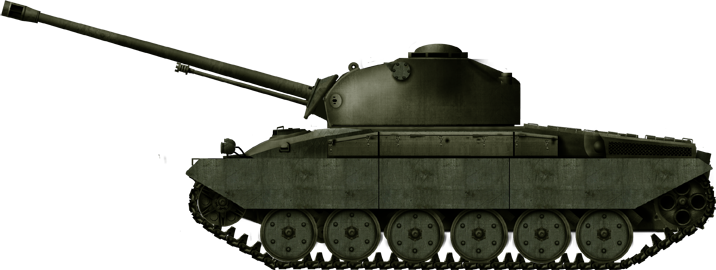
Kw30/57 prototype
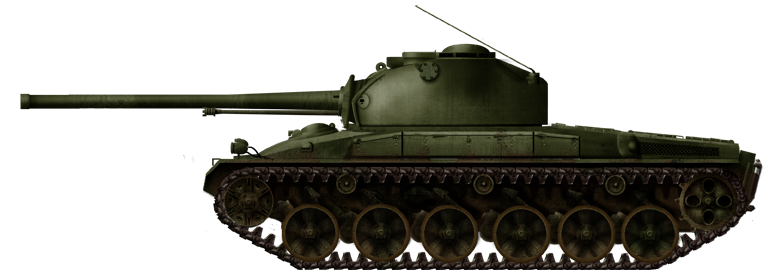
Panzer 58 as built in 1959.

KW-30 on trials

KW-30 orignal plans
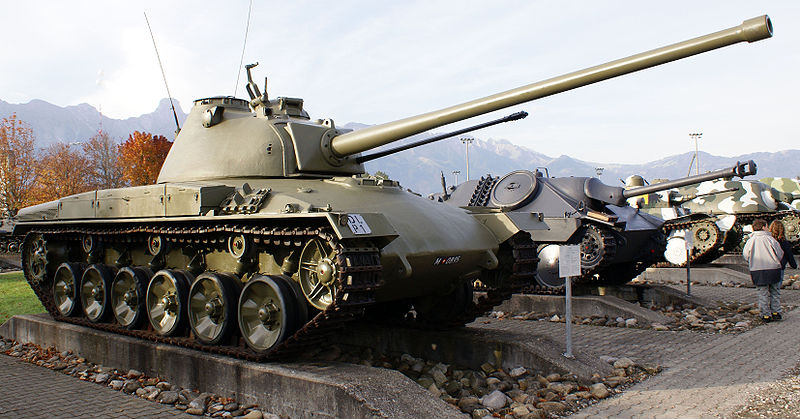
Second prototype at Thun museum near Bern
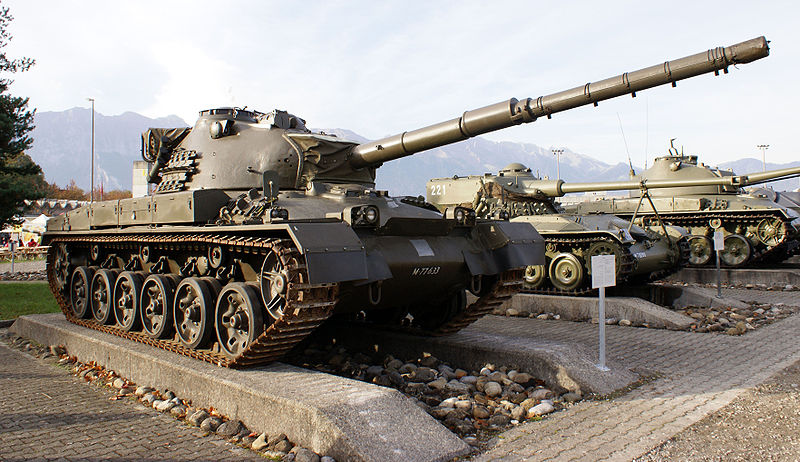
Panzer 61, the large production (150) successor, without the 20 mm aucocannon
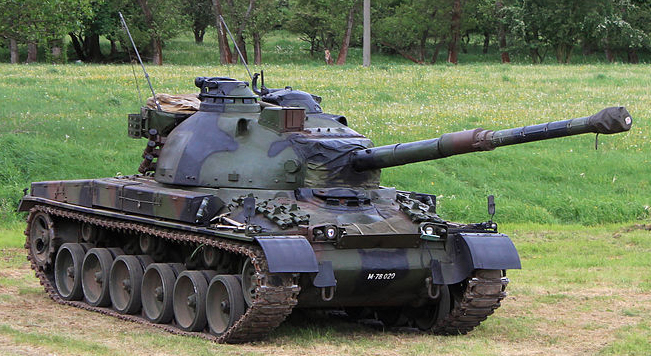
Final Kampfpanzer 68/88

Cold War Tanks


































Cold war tanks posters

Cold War Main Battle Tanks

Cold War Soviet Army
Museums, Movies, Books & Games
The Tanks and Armor in pop culture
Tanks and armored vehicles in general are only really grasped when seen first person: The mass, the scale, it's all there. Explore also the way tanks were covered in the movie industry, in books and in video games.Movies:
Best tanks movie on warhistoryonline.com
On imdb.com
On bestsimilar.com/
miltours.com
liveabout.com/
watchmojo.com
Video Games:
pcgamesn.com
historyhit.com
levvvel.com
vg247.com/best-tank-games
mmobomb.com/
alienwarearena.com

